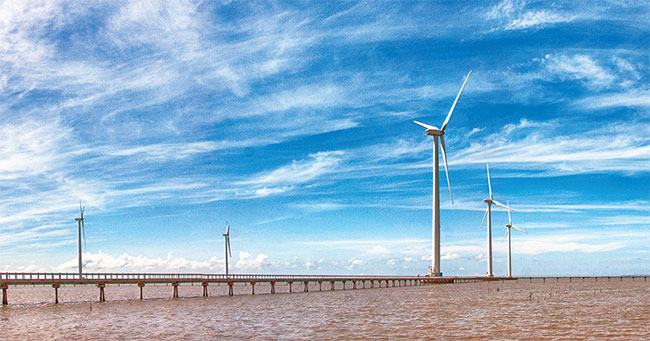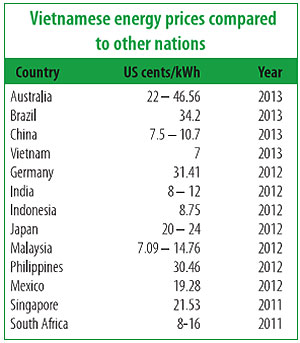Energy dilemma prompts a choice where sustai nability and security coincide

Too low levels of tarrifs paid for renewables have effectively priced green power out of the energy producing business
At a recent international conference on Vietnam’s implementation of the Millennium Development Goals, when talking about the role of renewable energy in sustainable development in Vietnam, Deputy Minister of Industry and Trade Tran Tuan Anh proposed that the government have specific investment incentives in place for local and foreign energy developers.
“The government would need to support investors and provide more tax incentives for programmes on using new energy and high technology,” Anh said.
He said Vietnam had huge potential for developing renewable energy sources like hydropower, biomass, wind power, solar energy and geothermal energy.
“However, the development and usage of renewable energy remains limited. Vietnam is likely to face energy shortages over the next 10 years due to an ever-rising demand for energy,” he warned.
 The concerns of growing demand
The concerns of growing demand
According to the United Nations Development Programme (UNDP) report on Vietnam’s green growth and fossil fuel fiscal policies released last year, national energy security is deteriorating as increased fossil fuel imports are required to meet the rising energy demand.
The MoIT reported that Vietnam’s power consumption grew 12.1 per cent during the 2001-2010 and 11 per cent during 2011-2014. The rate is expected to be 9.1 per cent in 2016-2020. Forecasts on consumed power volume indicated to reach 330-362 billion kWh by 2020 and 695-834 billion kWh by 2030.
While Vietnam is slowly becoming a net importer of coal, the government’s seventh power development plan targets a total electricity production capacity of 146,800 megawatts by 2030, 75,000MW of which is to be covered by coal fired plants.
By this forecast coal energy plants will produce approximately 394TWh of electricity, about 56.4 per cent of projected total electricity production. By 2030, 43,000MW of this power (or roughly a quarter of Vietnam’s electricity production) is expected to rely on about 80 million tonnes of imported coal a year, which is equivalent to the loads of 160 average-sized international cargo ship, or 60,000 average sized river barges, posing important transport challenges, apart from energy security issues.
“Reducing the rate of growth in domestic energy usage combined with the expansion of domestic renewable energy sources will significantly reduce Vietnam’s dependency on international energy markets and thereby enhance national energy security. This is also an opportunity for Vietnam to adjust its future power development plans, which rely heavily on imported coal,” said the report.
Feed-in tariffs in the way of development
The international business community has been urging the government to raise feed-in tariffs for renewable power to make the energy industry more attractive to potential investors.
Under the European Union’s (EU) €400 million ($520 million) cooperation programme with Vietnam, announced late 2014, Vietnam will receive $449.8 million in financial aid to facilitate sustainable energy development, including renewable energy sources.
However, “central to the issue of renewable energy development is an improved, level playing field for private sector investment, notably by the adjustment of electricity prices in line with market prices,” said Franz Jessen, Ambassador and Head of the EU Delegation to Vietnam.
The European Chamber of Commerce in Vietnam late last year published an whitebook, stating that due to the country’s extremely high potential for wind power in the region, Vietnam has received much attention from international investors and a number of such projects have been registered. However, the implementation of projects is often hampered by the current feed-in tariff of 7.8 US cents per kWh, which makes the recovery of the cost of investment increasingly difficult.
“As a result, most wind power developers have failed to secure financing, because the current tariff is not bankable. In our view, a feed-in tariff of at least 11.5 cents per kWh is required to reach the target of 1,000 MW of wind power by 2020, as set forth in the Power Master Plan VII,” said the book.
This revised tariff level would allow the development of proposed coastal/seaside projects, and the functioning of the majority of licensed wind sites in Ninh Thuan and Binh Thuan provinces, which have been delayed for many years, along with those in the central highlands, it said.
A prime example of this can be found in the private-owned Central Wind Power Joint Stock Company, which started developing its Phuong Mai 3 wind power project in Binh Dinh province in 1998. However, due to low feed-in tariffs, the project has been backtracked .
The company’s deputy director Bui Quang Ngan stated the project cannot be feasible until a feed-in-tariff of be around 11.5 cents per kWh is introduced.
Recently Danish wind turbine maker Vestas Wind Systems and Vietnamese firm Phu Cuong Group inked a memorandum of understanding to implement a 170MW wind power project worth $2 billion in Soc Trang province.
Constructions will begin early 2016, with the start of operations expected in 2017. The project will provide power for southern provinces, with a feed-in tariff of 9.8 cents per kWh.
Earlier, Vestas has also invested in a 6MW wind power farm in Binh Thuan.
Investors have been criticising the Vietnamese capping of electricity and fossil fuel prices, which amounts to substantial indirect government subsidies to energy prices. These policies are not fiscally sustainable and making investment in electricity from renewable energy unlikely, as it is characterised by high initial investment and administrative costs.
John Rockhold, head of the Vietnam Business Forum’s Power and Energy Sub-Working Group, said that in order to bolster renewable energy, there should be an attractive investment environment for private investors.
“As such, the Working Group backs the recommendations which call for an increase in the feed-in tariff level for wind energy and the simplification of application processes,” he said.
Furthermore, according to the Whitebook, project developers need more guidance to apply proper incentivisation specific to wind, biomass and waste-to-energy support mechanisms to their projects. In particular, they are uncertain about the process of securing feed-in tariffs and off-take agreements, which are essential for the feasibility and funding of the projects.
Deputy Minister of Industry and Trade Tran Tuan Anh has also suggested that the government would also need to “establish an effective energy market, with all economic sectors encouraged to participate on an equal basis and healthy competition.”
He said the power industry would need a total of $41.8 billion injected until 2020 for developing the country’s power system, amounting to $5.97 billion per year.
“But Vietnam’s feed-in tariffs remain low, making it difficult to attract local and foreign independent power investors,” he stressed.
What the stars mean:
★ Poor ★ ★ Promising ★★★ Good ★★★★ Very good ★★★★★ Exceptional
Latest News
More News
- Cement industry pleads for energy efficient tech (December 08, 2015 | 11:00)
- Going green to save a bundle (June 08, 2015 | 10:00)
- Green buildings: the rising trend (June 02, 2015 | 09:41)
- Green buildings – key to sustainable urban development in Vietnam (May 18, 2015 | 17:00)
- Feed-in tariffs continue to haunt green energy prospects (December 15, 2014 | 10:47)
- Building material types intrinsic to green ratings (December 09, 2014 | 11:56)
- Turning an eco- smart dream into reality (December 09, 2014 | 11:55)
- Green products enjoy a growing presence at Vietbuild Hanoi 2014 (December 01, 2014 | 10:06)
- Country profits from green building (November 24, 2014 | 11:02)
- Firms flout enviroment laws (November 17, 2014 | 10:48)
















 Mobile Version
Mobile Version